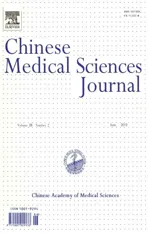Combination of Rapamycin and Imatinib in Treating Refractory Chronic Myeloid Leukemia Myeloid Blast Crisis:a Case Report△
2013-03-31JingXieXiangZhangBaozhiFangGuangshengHeYunZhaoandDepeiWu
Jing Xie ,Xiang Zhang ,Bao-zhi Fang ,Guang-sheng He *,Yun Zhao ,and De-pei Wu
1Key Laboratory of Thrombosis and Hemostasis of Ministry of Health,
2Cyrus Tang Hematology Center,Jiangsu Institute of Hematology,the First Affiliated Hospital of Soochow University,Suzhou 215006,China
CHRONIC myeloid leukemia (CML) is characterized by the presence of the BCR/ABL fusion gene,which is the result of a reciprocal translocation between chromosomes 9 and 22,called Philadelphia (Ph) chromosome.Imatinib mesylate (imatinib),a specific small molecular inhibitor of BCR/ABL,could improve the prognosis of CML and is now the standard drug applied in all phases of this disease.1Despite the efficacy of imatinib,the development of resistance and the persistence of minimal residual disease have seriously impaired the efficiency of this medicine.Resistance may develop through several different mechanisms,such as mutations in the Abl kinase domain,BCR/ABL overexpression,or compensatory phosphatidylinositol 3 kinase (PI3K)/Akt/mammalian target of rapamycin (mTOR) activation.2,3Rapamycin,with mTOR as a potential therapeutic target,has been studied in patients with hematologic malignancies.Here we report a case of refractory CML myeloid blast crisis successfully treated by the combination of rapamycin and imatinib.
CASE DESCRIPTION
A 30-year-old man was diagnosed with CML chronic phase in the Department of Hematology in our hospital on December 7,2003 and treated with interferon-α and hydroxyurea immediately.After 9 months,bone marrow aspiration of this patient showed CML myeloid blast crisis.Immunophenotyping of the leukemia by flow cytometry showed CD2 0.5%,CD7 24.7%,CD11 1.2%,CD19 1.0%,CD20 1.0%,CD13 41.5%,CD33 29.9%,CD14 1.5%,CD34 49%,CD117 1.9%.Cytogenetic analysis revealed 46,XY,t(9;22)(q34;q11)/[10].Reverse transcription-polymerase chain reaction (RT-PCR) detected BCR/ABL fusion gene at 8821/10 000ablcopies.These results supported the diagnosis of CML myeloid blast crisis.Because a human leukocyte antigen-matched donor was not available,imatinib at 600 mg/d was administered.Within 2 months,the therapy induced a complete hematological remission and major cytogenetic response.BCR/ABL fusion gene reduced to 6604/10 000ablcopies.However,after 4 months,BCR/ABL fusion gene ascended to 8010/10 000ablcopies and loss of partial cytogenetic response was observed despite hematological remission.The dose of imatinib was raised to 800 mg/d.After 2 months,cytogenetic analysis revealed 46,XY,t(9;22)(q34;q11)[2]/49,XY,idem,+5,+22,+Ph[3]and RT-PCR detected BCR/ABL fusion gene at 2637/10 000 ablcopies.During the following 12 months,imatinib at 800 mg/d was continued and hematological remission maintained,but BCR/ABL fusion gene rose to 9746/10 000ablcopies and cytogenetic analysis on May 14,2005 revealed 46,XY,t(9;22)(q34;q11)/[10].
In this patient,phosphorylated mTOR and S6 were expressed in CD33+cells detected by flow cytometry,and could be inhibited by administration of siromilusin vitro.Rapamycin at 1 mg/d was combined with imatinib at 800 mg/d to treat the patient,with dose adjustment allowed to reach a target serum rapamycin concentration of 4 ng/mL.After 3 months,BCR/ABL fusion gene reduced to 6101/10 000ablcopies and after 11 months to 4423/10 000ablcopies,while cytogenetics did not show remission.The patient was well tolerant to the combination therapy,hypertriglyceridemia and hypercholesterolemia developed but did not mandate the termination of rapamycin.Bone marrow aspiration showed remission.So far,the patient has survived for over 29 months under the combined treatment of rapamycin and imatinib after CML myeloid blast crisis.
DISCUSSION
BCR/ABL fusion protein phosphorylates several substrates that activate multiple signaling pathways,including Ras,extracellular signal-regulated kinase/mitogen-activated protein kinase,PI3K,etc.4The abnormal signaling leads to increased proliferation and apoptosis inhibition.
mTOR is a downstream effector of the PI3K/Akt signaling pathway,which mediates cell survival and proliferation.mTOR activity is potently inhibited by rapamycin,which appears very efficient in treating tumors displaying activation of the PI3K/Akt pathway.5,6In addition,rapamycin was reported to weakly inhibit the growth of myeloid leukemia cell lines such as HL60,U937,and K562.7,8
Burchertet al3demonstrated that imatinib activated the PI3K/Akt/mTOR pathway in BCR/ABL-positive LAMA-cellsin vitro,as well as in a patient with chronic phase CML.They concluded that inhibition of imatinib-induced Akt activation using mTOR inhibitors and Akt-specific siRNA effectively antagonizes the development of imatinib resistancein vitro.
Mohiet al9reported that rapamycin synergizes with imatinib against BCR/ABL transformed myeloid cells and increases survival in a murine CML model.Mayerhoferet al10also found that rapamycin inhibits the growth of primary CML cells in all imatinib-resistent CML patients in a dose-dependent manner and exerts synergistic inhibitory effects with imatinib on the growth of Ba/F3 cells containing imatinib-resistant mutants of BCR/ABL.
The patient in this case achieved long-term survival under the combined treatment of rapamycin and imatinib after CML myeloid blast crisis,suggesting a new therapy for imatinib-resistant patients.
1.Deininger M,Buchdunger E,Druker BJ.The development of imatinib as a therapeutic agent for chronic myeloid leukemia.Blood 2005;105∶2640-53.
2.Walz C,Sattler M.Novel targeted therapies to overcome imatinib mesylate resistance in chronic myeloid leukemia(CML).Crit Rev Oncol Hematol 2006∶57∶145-64.
3.Burchert A,Wang Y,Cai D,et al.Compensatory PI3-kinase/Akt/mTor activation regulates imatinib resistance development.Leukemia 2005;19∶1774-82.
4.Barnes DJ,Melo JV.Management of chronic myeloid leukemia∶targets for molecular therapy.Semin Hematol 2003;40∶34-49.
5.Hidalgo M,Rowinsky EK.The rapamycin-sensitive transduction pathway as a target for cancer therapy.Oncogene 2000;19∶6680-6.
6.Podsypanina K,Lee RT,Politis C,et al.An inhibitor of mTOR reduces neoplasia and normalizes p70/S6 kinase activity in Pten+/-mice.Proc Natl Acad Sci U S A 2001;98∶10320-5.
7.Yamamoto-Yamaguchi Y,Okabe-Kado J,Kasukabe T,et al.Induction of differentiation of human myeloid leukemia cells by immunosuppressant macrolides(rapamycin and FK506) and calcium/calmodulindependent kinase inhibitors.Exp Hematol 2001;29∶582-8.
8.Ly C,Arechiga AF,Melo JV,et al.Bcr-Abl kinase modulates the translation regulators ribosomal protein S6 and 4E-BP1 in chronic myelogenous leukemia cellsviathe mammalian target of rapamycin.Cancer Res 2003;63∶5716-22.
9.Mohi MG,Boulton C,Gu TL,et al.Combination of rapamycin and protein tyrosine kinase (PTK) inhibitors for the treatment of leukemias caused by oncogenic PTKs.PNAS 2004;101∶3130-5.
10.Mayerhofer M,Boehm A,Aichberger KJ,et al.In vitroandin vivoantileukemic effects of the mTOR-targeting drugs rapamycin in patients with imatinib-resistant CML.Blood 2005;106∶abstract 4834.
